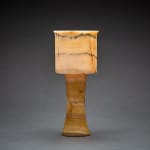Bactrian Alabaster Chalice, 2000 BCE - 1500 BCE
Alabaster
height 22.9 cm
height 9 in
height 9 in
LO.1008
Elongated alabaster chalice with slightly everted rim, the sides straight, the long stem slightly splayed at the base. Through the regions of Margiana and Bactria local stone carvers experienced no...
Elongated alabaster chalice with slightly everted rim, the sides straight, the long stem slightly splayed at the base.
Through the regions of Margiana and Bactria local stone carvers experienced no shortage in material; the main raw material was soft steatite or a dark soapstone, but also various kinds of marble and white-veined alabaster. The main source for these stones, including semi-precious lapis-lazuli, was in Bactria, at Badakhshan in north-western Afghanistan, which provided material not only for the Bactrian and Margian carvers but also farther to the west into Mesopotamia, for the Assyrian kings. White-veined alabaster was indeed used for varied vessels, including small vases with disproportionately long stems and low capacity, such as the one here illustrated. ,p>
For a comparable Bactrian example see, V. Sarianidi, Margus, Turkmenistan, 2002: p.136.
Through the regions of Margiana and Bactria local stone carvers experienced no shortage in material; the main raw material was soft steatite or a dark soapstone, but also various kinds of marble and white-veined alabaster. The main source for these stones, including semi-precious lapis-lazuli, was in Bactria, at Badakhshan in north-western Afghanistan, which provided material not only for the Bactrian and Margian carvers but also farther to the west into Mesopotamia, for the Assyrian kings. White-veined alabaster was indeed used for varied vessels, including small vases with disproportionately long stems and low capacity, such as the one here illustrated. ,p>
For a comparable Bactrian example see, V. Sarianidi, Margus, Turkmenistan, 2002: p.136.



